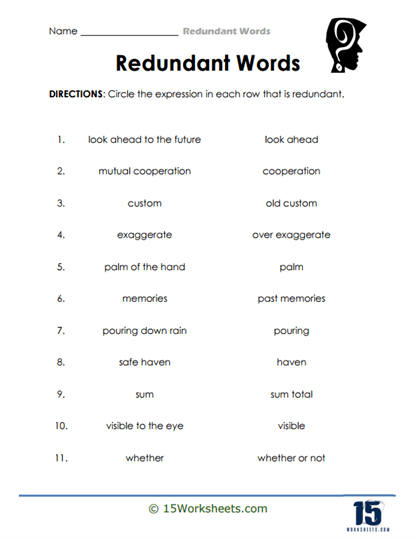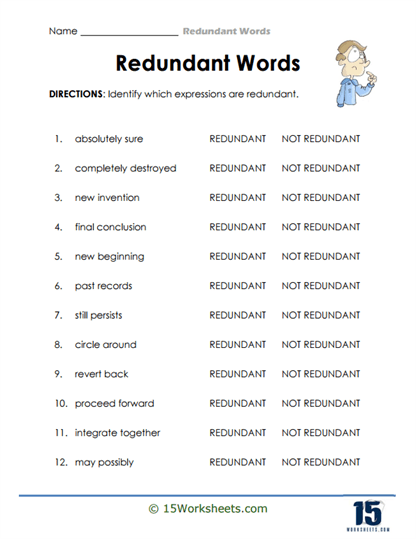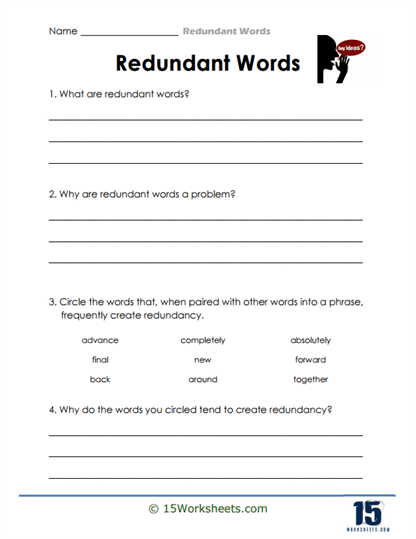Redundant Words Worksheets
About These 15 Worksheets
This series of worksheets offers a comprehensive suite of activities designed to help students, teachers, and homeschoolers refine writing skills by eliminating unnecessary redundancies. These worksheets are specifically crafted to enhance clarity and precision in writing, allowing students to convey their ideas more effectively.
The worksheets cater to a wide range of learning needs. For instance, one set of worksheets requires students to underline redundant words within sentences, prompting them to identify and eliminate superfluous language. This exercise is fundamental in teaching students to recognize redundancy in their writing, ensuring their sentences are concise and impactful.
Another set of activities involves rewriting sentences to remove redundant words while maintaining the original meaning. This task not only reinforces the identification of redundancies but also encourages students to think critically about word choice and sentence structure. By rewriting the sentences, students practice streamlining their thoughts, making their writing more efficient and polished.
There are worksheets where students replace wordy or redundant phrases with a single, more effective word. This exercise sharpens their vocabulary and helps them understand the power of word economy in writing. Students learn to express complex ideas succinctly, which is a crucial skill in both academic and real-world writing.
The collection also includes worksheets that ask students to match redundant expressions with their more concise counterparts. This matching exercise helps solidify the understanding of common redundancies and their corrections, reinforcing the lessons in a fun and interactive way.
Some worksheets challenge students to identify which expressions are redundant within a list of phrases. This task not only tests their knowledge but also improves their ability to self-edit, a valuable skill in any writer’s toolkit.
Beyond the types of worksheets showcased, this collection also include activities such as peer review exercises, where students exchange their written work to identify redundancies in each other’s sentences. This collaborative approach helps students learn from each other and see how redundancies can appear in various contexts.
Another part of the collection might be editing exercises where students are given longer paragraphs filled with redundancies. Their task would be to edit the entire passage, making it more concise without losing the intended meaning. This would be particularly useful in helping students understand the importance of brevity in more extended pieces of writing.
Sentence combination exercises are introduced, where students merge sentences in ways that eliminate redundancy and improve flow. This type of activity helps students see how sentences can be restructured for better clarity and impact.
The collection’s versatility makes it an invaluable resource for anyone aiming to improve writing efficiency. Available in PDF format, the worksheets are easy to view, download, and print, providing convenience and accessibility for students, teachers, and homeschoolers alike. This collection of worksheets serves as a practical tool for fostering clear, concise, and effective communication.
What Are Redundant Words?
Redundant words in grammar refer to words or phrases in a sentence that are unnecessary because they repeat something that has already been said or implied. Redundancy occurs when a writer or speaker uses more words than needed to convey a message, which can make the writing or speech less clear, less direct, and more cumbersome. For instance, phrases like “free gift,” “advance planning,” or “close proximity” contain words that add no additional meaning because the primary word (“gift,” “planning,” “proximity”) already conveys the full idea.
In writing, redundant words can dilute the strength of an argument or narrative. By adding unnecessary words, the core message becomes less sharp, and the writing loses its punch. For example, saying “In my personal opinion, I believe” could be shortened to “I believe” without losing any meaning. The removal of redundancies helps to make writing more concise and focused, allowing the reader to grasp the essential points quickly. Concise writing is especially valued in academic and professional settings, where clarity and precision are key.
Redundancy often occurs unintentionally, as speakers or writers try to emphasize a point or ensure clarity. However, this well-meaning repetition can lead to verbosity, which may confuse or bore the audience. In some cases, redundancy can stem from a lack of confidence in the clarity of the initial expression, leading the speaker or writer to over-explain. This can be particularly common in early drafts of writing, where ideas are being explored and refined.
Identifying and eliminating redundant words is a crucial step in the editing process. The purpose of this practice is to refine the text, making it more efficient and impactful. By cutting out unnecessary words, the writer can strengthen their message and ensure that every word counts. This not only improves readability but also enhances the overall quality of the writing. In addition, learning to recognize redundancies can help writers develop a more disciplined and intentional approach to their craft.















